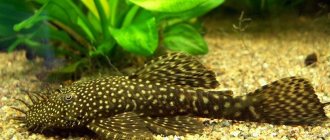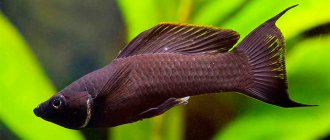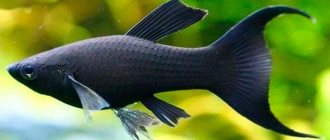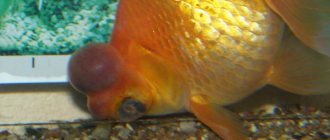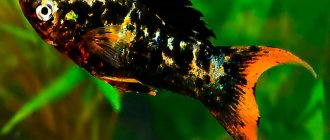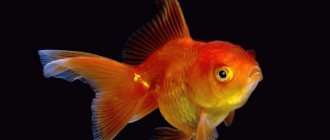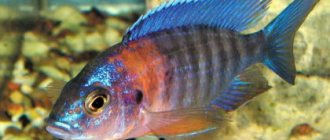A beautifully decorated aquarium immediately attracts the attention of everyone in the room from the very first minutes. And this is not at all surprising, because how can you tear yourself away from looking at the colorful landscapes, amazing plants and, of course, its inhabitants - aquarium fish.
Various in size and shape, they simply fascinate with their leisurely movement. And this is not to mention the colorful color design of each of them. So in one artificial reservoir there are red, orange, blue and even yellow aquarium fish. And if the division by families and species is familiar to every aquarist, then the division by color actually does not occur anywhere. And in today’s article we will try to combine fish of certain colors into one general group.
Description
Mollies belong to the genus of viviparous fish, which means that they do not lay their eggs in a safe place, but the eggs and fry develop inside them until they are ready for the outside world. The black fish called Black Molly was first artificially bred in 1909. It was then that the species from the Poeciliaceae family became widespread.
The range is wide, yellow mollies are able to adapt to new environmental conditions, so they have mastered fresh and brackish water bodies. But the largest concentration of fish is found in central and northern America and in the vicinity of the Yucatan Peninsula.
In their natural environment, mollies are not so brightly colored; the more common coloring is gray with faint tints of yellow and green with camouflage spots. But breeders received a fish with a rich yellow color, sometimes with an orange or green tint. Often small orange spots are visible on the fins and head. A closely related color is the black and gold molly, half of the body of which is painted black.
The length does not exceed 10 cm in an aquarium. The body shape is widened in the center and greatly tapered in the tail and head. The fins are transparent, sometimes spotted. Particularly prized are individuals with a tail that has extensions at the ends. They are called lyretail golden mollies.
The order Poeciliidae includes, in addition to the golden one, 30 more species of mollies.
The most common ones are:
- Molly peten. The most famous color of this mollies is gold and black. A distinctive feature is that there is a red stripe on the fins, which clearly distinguishes them from other fish.
- Broad-finned. It is distinguished by its large size - up to 20 cm. Body color ranges from blue to orange.
- Sphenops or coal. Molly, common among aquarists for more than 8 decades. The size is no more than 7 cm. The body seems to be flattened, the fins are smooth and rounded.
- Balloon. The Latipine subspecies is distinguished by a short, seemingly crooked body and a plump, strongly protruding abdomen. The fins against the background of a medium-sized body look more aesthetically pleasing than on other species.
- Small-finned. This species has reduced fins, especially the dorsal one. The body is elongated, without a protruding belly. The most common colors are blue, gray, brown, silver.
Lifespan
The average lifespan of mollies in an aquarium with proper maintenance ranges from 4 to 5 years. But monotonous feeding, untimely cleaning of the aquarium, and overcrowding of the tank significantly shorten the lifespan of the fish to 2 years. Females usually live longer.
Kinds
Golden Gyrinoheilus are more common in aquariums. Forms with natural colors can be seen less often. Species available for sale are those that are bred on farms rather than those caught in the wild. All species differ only in color, the conditions of detention and character are the same.
Ordinary
Color ranges from yellow to olive with black splashes. The scales are edged with dark.
Siamese
The color is yellow and orange, there may be spots. Not to be confused with the Siamese algae eater - the owner of a longitudinal black stripe on the body and a mouth with a different structure.
Gold
Body color is golden. Dark spots on the body may be present.
Yellow
The yellow algae eater differs from the golden variety in its uniform color distribution.
Albino
The owner of a light pink body with a golden tint.
Marble
The color is light brown with dark spots. The scaly pattern is clearly visible. The tail is translucent with black dots.
Maintenance and care
Caring for mollies mainly involves maintaining clean water and parameters for comfortable life of the fish. The inhabitants are less picky about other conditions, so they are suitable as a first pet for a novice aquarist.
Weekly water changes in the amount of ¼ of the aquarium volume. It is necessary to siphon the soil depending on the degree of contamination and the number of inhabitants, but usually cleaning is carried out once every couple of months. A complete cleaning of the aquarium is required once a year.
It is not necessary to keep fish in a school, but it is advisable. Wide opportunities open up in the combination of neighbors due to the peaceful and non-aggressive nature of yellow mollies.
Aquarium
Although the fish are considered unpretentious, they cannot be kept in cramped and crowded aquariums. There should be more than 10 liters of water per fish. In close quarters, unusual traits appear for them - aggressiveness and hostility towards everyone around them.
Water parameters
- The temperature is not lower than 24 and not higher than 28 degrees.
- Water hardness is from 22 to 28 dGH.
- Water acidity is from 7.0 to 7.9 pH.
- The salinity of the water is no more than a teaspoon per 10-liter aquarium.
Plants
Yellow fish are shy by nature, so they need dark, secret hiding places in which they feel safe. The role of shelters is performed by plants with dense foliage. Therefore, plant in the aquarium:
- Alternanter.
- Aponogeton.
- Barclaya longifolia.
- Vallisneria.
- Hygrophila.
- Brazilian pinnate.
- Echinodorus.
- Lagarosiphon curly.
Equipment
To keep the aquarium clean and free of fish waste, install a filter in the tank. A condenser will help enrich the water with oxygen.
Lighting
Fish in their natural environment live among reservoirs with a lot of sunlight, so provide 12-hour lighting in the aquarium. In summer, for lighting, it is enough to place the aquarium next to the window (but without direct sunlight). In winter, the missing light is compensated with additional lighting.
Priming
For mollies, the substrate for the bottom does not matter, but river sand or crushed pebbles are more often chosen.
Interesting Facts
The yellow fish is quite inexpensive, but its beauty and original behavior will not leave anyone indifferent.
Labidochromis Yellow loves to dig. Therefore, frequent rearrangement of decorative items in their pond is a common occurrence.
Experienced aquarists have concluded that if hummingbird cichlid fry are kept in a container with algae from birth, they get used to it and do not destroy it.
Yellow cichlids are famous for their vitality due to the high intelligence of the species. Their fry are able to survive in captivity, even in close proximity to predatory cichlids. And if they are kept very well, they can live up to 10 years.
Fish are famous for their vitality due to the high intelligence of the species
Labidochromis Yellow is rightfully worthy of admiration for its amazing coloring, ease of keeping, resistance to disease, unusual behavior and peaceful disposition. You just need to put in a little effort.
Have you kept fish of this species in your aquarium? What features of caring for them would you like to note? Share your experience in the comments.
Feeding
They are unpretentious when feeding and will eat any food offered. But this implies the possibility of overeating, so carefully monitor the amount of food given and if the fish are obese, reduce the portions. Feeds on live, dry and frozen food. Feeding them alive with bloodworms, earthworms, and daphnia is suitable. vipagran sera can become the basis of fish food.
Plant foods are also important in the diet. It includes lettuce, cucumbers, dandelion leaves, and apples.
Yellow mollies eat mud from the walls of the aquarium and some types of algae, keeping the tank clean.
Danio rerio Glofish
These are genetically modified fish in several different fluorescent neon colors, created by scientists by introducing a fluorescent protein from marine organisms into zebrafish embryos. Dyes and color injections were not used for these fish, and the offspring inherit the resulting gene from their parents.
These fish were created to detect environmental pollution and were supposed to fluoresce only in dirty water. Scientists are still working on this, and aquarists have already received amazingly beautiful and bright pets that glow under ultraviolet light. If you want to see your fish glow, shine a blue light on them. The glow will be white, but not very bright.
Danio glofish exist in the following colors:
Glowing fish, just like ordinary zebrafish, are surprisingly hardy, unpretentious, and can adapt to any water parameters. They are recommended for keeping by beginners, so any beginner can please himself with these small, brightly colored fish. However, Glofish fish are not cheap.
For zebrafish glofish you need an aquarium with a volume of 40 liters or more, since these fish need to be kept in a group of 6 or more individuals. You can feed any small food.
Compatibility
Mollies in many sources about fish compatibility are indicated as a species that gets along with all its neighbors, excluding predators and aggressors. The fish are peaceful in nature and treat the other inhabitants of the aquarium neutrally, without showing aggression. Get along together: gouramis, catfish, ancistrus, neons, rhodostromus, thornets, platies.
But sometimes mollies bite the fins of other fish, most often angelfish. But the fish themselves are attacked and bitten by other species: barbs, guppies, swordtails, veiltails, telescopes. A hierarchy is built among predators, and peaceful, medium-sized fish occupy the lowest places in it. Therefore, life in such a neighborhood will cost the mollies health, nerves, or even life. Do not keep with cichlids, clarius, snakeheads, tetradons.
In the photo, the sexual differences between the male and female Labidochromis yellow
How to deal with harem? How to choose boys and girls? Honestly, despite all the years of our practice with these fish, there is only one piece of advice - rely on luck. Like many cichlids, Yellow Boys are brighter and have pointed dorsal and anal fins. Females are less bright, the fins are not sharp. But the thing is that at a young age these signs are barely visible, plus the fish run around like crazy. We don’t think that in a pet store you will be 100% able to make correct identification.
And most importantly, in the Labidochromis clan, like any other Malawians, their own hierarchy is established. There is a harem, there are dominant males who really look like bulls in a bullfight. But there are also rogue males who, by color and behavior, are quite easily confused with females.
A sure sign of sexual difference is mating games, in which it is immediately clear that xy is from frau, and xy is from her. Well, from the fact of these games you can immediately see the mother with a bloated pack in which she incubates her offspring.
The spawning process itself in labidochromis is typical.
The male finds a “secluded place” and often digs a hole where the female lays her eggs. After the eggs are fertilized, the female incubates it in her mouth for a month (24-40 days). At the end of this period, completely independent juveniles (10-30 tails) are born. Usually the female guards and protects her offspring for another week, and then releases them “to swim freely.”
By the way, the incubation of eggs is generally a separate song and an ode to the evolution of the Malawians. All Malawian females incubate their eggs this way - in their mouths and do not eat anything for weeks. By the end of gestation, their mouth looks like an English bulldog's pack, but they still do not release or swallow the babies until the fry become completely independent. After the mother has released her kindergarten squad, the fry are absolutely independent and can feed on the same basis as adults. But at the same time, at the first danger, the mother can open her mouth again and the fry themselves swarm towards her. And this is simply an amazing mechanism that one can only admire.
In general, dear friends. The Malawian cichlid is no less popular and fascinating trend in aquarium hobby than aquascaping. And most importantly, it’s not so complicated. At the same time, in return, you get amazing games, you will be able to see true maternal love, clannishness, the formation of a hierarchy and other delights that these absolutely boring fish will give you.
Diseases
- Gas embolism is manifested by an excess of oxygen in the fish’s body, due to which the blood vessels close. It manifests itself as bruises and bruises on the body, cloudy eyes, lethargy, and anxiety. To avoid this, carefully monitor the aquarium aeration process.
- Colds are caused by sharp drops in temperature, which is very dangerous for heat-loving mollies. The fish refuse to eat and become passive. For treatment, it is enough to return the temperature to levels that are comfortable for the inhabitants.
- Ecto- and endoparasites. If you do not keep the aquarium clean, parasites enter the fish's body. Golden mollies will fuss, get nervous, rub against the walls of the aquarium and stones, and refuse food. Treatment with antibiotics or baths with solutions.
- Infection. A dirty aquarium leads to infectious diseases; pets are passive, photophobic, and nervous. Treatment with antibiotics.
How to choose the right one when purchasing
It is unlikely that you will find fresh lakedra in the store; most likely it will be either frozen or already thawed specimens. When purchasing, you should give preference to the latter option, since the quality of frozen meat is difficult to assess. Pay attention to:
- Eyes - they should be clear and bright.
- There should be bright gills with the smell of the sea.
- There should be no stains on the carcass.
Signs of staleness: - weathered carcass with defects, dry fins and tail; - loose and inelastic meat.
Reproduction
The sexual maturity of fish and their readiness to reproduce in yellow mollies manifests itself after six months of life. Young representatives are fully formed and independent by this time. To determine readiness for spawning, you need to monitor the behavior of the female. She carefully explores all the secluded places of the aquarium, looking for a safe place for herself, a shelter. Her abdomen is rounded due to the accumulation of caviar. Males begin to compete with each other and arrange fights for females. During this period, the pregnant female molly is placed in a specially prepared spawning tank with water at a temperature of 30 degrees and good lighting.
A female can give birth to up to 120 fry, usually 70, which are immediately viable and ready to feed and swim. But they still need carefully crushed live food from daphnia, rotifers, and cyclops. After giving birth, the female is returned to the general aquarium. A month after birth, the fry reach the size of adult fish and are transplanted into a common aquarium.
The golden mollies have a distinctive feature in the fry of the species - they are not born golden, like their parent fish, but with a dark, grayish color. Only after a couple of weeks does the color take on its usual yellow color.
How to cook delicious lakedra
We can say that lakedra is a national Japanese dish, keeping in mind all the variety of recipes. Although Korea may also think so about itself. And neighbors in the region have long appreciated its taste.
Yellowtail has few small seeds and is easy to clean, both to remove scales and to remove fillets.
The most famous Japanese treat is hamachi teriyaki, which means fried yellowtail. The main secret of the popularity of this dish is its marinade, half consisting of alcoholic beverages (sake and sweet mirin wine), of course, soy sauce and dashi broth.
Europeans, especially southerners, also appreciated its culinary qualities, so meat is also actively used in European cuisine.
Yellowtail lakedra meat
What does lakedra taste like?
The meat is reddish in color, soft and fatty, has a pleasant taste, similar to tuna. It is used both after heat treatment and fresh - in Japan it is popular for preparing traditional sushi and sashimi.
Lakedra in a frying pan, recipe
Almost the fastest way to cook - half an hour for everything.
The meat is dense, with a pleasant aroma, so it is better to fry it in steaks 2 cm thick. It is better to use corn flour and a couple of eggs; for the marinade you will need half a lemon.
Preparation:
- 10 minutes for marinade: place 6 steaks on a cutting board. Season with salt and pepper, quickly move your hand over the steaks, squeezing the juice from half a lemon. Turn the steaks over and repeat.
Preparation:
— Roll each steak in flour, then in egg and again in flour. — Fry in a hot frying pan until golden brown on both sides.
Lakedra in a slow cooker
It is prepared like any other fish. Possible options:
- Frying in oil with vegetables or in sauce (tomato or sour cream).
- Steamed - portioned pieces of fish are salted, peppered, and greased with vegetable oil. Place on a steam rack over a bowl of water.
Lacedra recipe in the oven
Of the many options for cooking in the oven, there are 2 most common:
- in foil;
- without foil - under a vegetable coat.
Let's talk about the most delicious - combined method:
Lakedra in foil on an onion pillow
Ingredients: lakedra – 1 piece (~1kg); onion – 2 pcs (large); mayonnaise – 2 tablespoons; sl. butter – 20 g.
- Salt the cleaned and gutted fish on both sides. Half an hour, maximum an hour before cooking, grease a kilogram carcass with mayonnaise. Cut two large onions into half rings. Place the chopped onion in a deep plate, add salt and mash the onion with your hands.
- Turn on the oven at 200 degrees. While it is heating up, you need to prepare a deep baking sheet: - cover the bottom with foil (necessarily strong), sprinkle a little vegetable oil on it and pour in the onions, distributing them evenly over the bottom; - place the fish carcass on it, placing a piece of butter inside it.
- Cover the baking sheet with foil, wrapping it around the edges and pressing the edges to them, place the baking sheet in the oven.
- After 35 minutes, remove from the oven, carefully remove the foil and grease with the remaining mayonnaise.
- The onion should have given abundant juice when mixed with the oil from the carcass. You need to scoop up this juice with a spoon and pour it over the fish several times.
- Without the top foil, place the baking sheet in the oven for 12 minutes.
- Finally remove the pan, moisten the fish with the remaining juice from the bottom and cover with foil for 15 minutes. You can cover the top with a towel.
The dish is ready. Tasty and healthy.
Attention! Since reviews of the classic preparation of lakedra in foil complained about dryness, this is the option presented - with guaranteed juiciness of the fish and a well-done crust. The juice from the onion rings and melted butter provide this, as well as pre-lubricating the meat with mayonnaise.
Reviews
Yellow mollies, according to aquarists, decorate the tank with their color. They are not picky about living conditions. But difficulties arise during reproduction.
Diseases
Under good conditions, labidochromis does not get sick. With infrequent aquarium maintenance and incorrect water parameters, the yellow cichlid is susceptible to:
Photo gallery
Ternetia Glofish
Another genetically modified species obtained using the DNA of a sea jellyfish. The “basis” for luminous tetras was black tetras or ternets (Gymnocorymbus ternetzi).
In 2012, a new electric green glofish appeared. In addition to the electric green, the following thorns were obtained:
- cosmic blue;
- red starfire;
- sunny orange;
- galactic purple;
- pink moonrise.
Genetically modified fish differ little from their ancestors. Glofish tetras are also hardy, unpretentious, with the same behavior and even lifespan. They eat any food offered. Colored tetras are hardy and recommended for beginners. They like to live in groups of 6-8 fish.
Adviсe
- Keep with slow or too fast fish, to which mollies are indifferent.
- Do not introduce veil-tailed fish with long fins.
- Watch your fish diet and avoid overeating.
- Monitor the number of fish in the aquarium and prevent overpopulation, because mollies reproduce every 1.5 months and without control will quickly increase the number of inhabitants.
Due to the color scheme and ease of keeping, the yellow molly will for a long time be the standard of the first fish that every beginning aquarist should have.
Previous
Varieties of aquarium telescope fish (large bulging eyes, goggle-eyed, telescopic): types (black, gold), content
Next
Varieties of Blue Tang (fish paracanthurus hepatus): types (white-breasted or leucosternon, lineatus, triostegus, Japanese, pyroferus), maintenance, feeding, compatibility
Great article 0
Orange
Such aquarium fish are perfect for any decor of an artificial pond, giving it even more charm. In addition, quite often representatives of this color group surprise with their unusual and original body shapes. So among them we can highlight:
- veiltails;
- celestial eye
Let's talk about each of them.
Veiltail
Such aquarium fish are inhabitants of almost every artificial reservoir around the world. As for their appearance, the first thing worth noting is the attractive color shade, rounded body and forked tail. Some even compare veiltails to the famous “goldfish”. But this is not the only thing that makes them so popular. So, these are one of the most unpretentious fish and are not very demanding in nutrition. The only thing worth considering when keeping veiltails is their intolerance to their tropical neighbors and their desire to dig in the ground for a long time.
Aquarium fish for a small aquarium
In fact, all Apistogramma can be kept in small aquariums. These are beautiful and very interesting fish, but they are breathy. Keep in mind that they do not live long, are sickly and suffer if they reach 2 years of age. Minimum volume per couple
A rare and very specific small fish. Not for everyone.
This is a whole galaxy of carp-toothed fish - Afiosemion , Nothobranchius , etc. Small fish, interest in which is caused not so much by their beauty, but by their method of reproduction. These “one-year-old fish” naturally live in puddles and ditches. This is where the eggs are laid. Soon the puddle dries up, the adults die, and the eggs remain lying in completely dry soil. The eggs are so oaky that they can withstand any heat, elephants and hippos walk on them, and they don’t care. They are waiting for the first drops of rain! And as soon as this happens, new life appears from the eggs.
